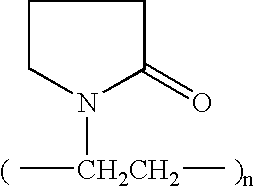Ruthenium-barrier polishing slurry
a technology of ruthenium barrier and polishing slurry, which is applied in the direction of other chemical processes, manufacturing tools, chemistry apparatus and processes, etc., can solve the problems of too thick copper seed layer for commercial practicality, and achieve the reduction of reducing the dielectric removal rate, and reducing the removal rate of nonferrous interconnect metals
- Summary
- Abstract
- Description
- Claims
- Application Information
AI Technical Summary
Benefits of technology
Problems solved by technology
Method used
Image
Examples
example 1
[0031]This example shows the effect of pH on the removal rate of ruthenium and other films. Table 1 lists the slurry compositions. Table 2 lists the removal rate corresponding to these compositions.
TABLE 1BTA,EDTA,Periodic acid,Klebsol 1501-50,Slurrieswt %wt %wt %wt %pHA0.10.003840.5102.8B0.10.003840.510410.10.003840.510920.10.003840.5101030.10.003840.51011BTA represents benzotriazole.Klebosol 1501-50 is a colloidal silica abrasive with an average particle size of 50 nm, from AZEM.EDTA represents ethylenediaminetetraacetic acid.
TABLE 2Ru RRCu RRTaN RRTEOS RRCDO RRSlurries(Å / min.)(Å / min.)(Å / min.)(Å / min.)(Å / min.)A1181949324367307B971514278297260135421930056872222512514415618603240371511559825
[0032]Based on the above data, it was determined that alkaline pH provided higher Ru removal rates and much lower Cu removal rates than that achieved at acidic pH levels.
example 2
[0033]This example examines the effect of surfactants with ethylene oxide groups (—CH2—CH2—O—) on film removal rates. All formulations in Table 3 (slurries 4-12) are based on slurry 1. In addition to the chemical additives listed in the table, the slurries also contain the same amounts of BTA, EDTA, Periodic acid, PL1501-50, and has the same pH as slurry 1. The molecular formulas of these surfactants are listed in Table 4. It can be seen that all surfactants have ethylene oxide groups (—CH2—CH2—O—).
TABLE 3DisponilTergitolFES 32 IS,Brij 35ChemEENPluronicNP-9,Slurries(wt %)(wt %)T-5 (wt %)L31(wt %)(wt %)pH40.001950.01960.05970.02980.1990.029100.19110.059120.29Disponil PBS 32IS is a fatty alcohol polyglycol ether sulfate from Cognis Corporation.Brij 35 is a polyethylene glycol ether of lauryl alcohol from Uniqema.ChemEEN T-5 is a polyethylene glycol amine of hydrogenated tallow from Chemax Inc.Pluronic L31 is a polyoxyethylene, polyoxypropylene block polymer from BASFTergitol NP-9 is a...
example 3
[0036]This example examines the effect of some chemical additives with amide groups on the film removal rate. The general formula for the amide functional group has the following form:
[0037]R is hydrogen or an organic radical.
[0038]Two chemical additives are shown in this example. One is a surfactant named Incromide CA. It is an ethanolamide of coconut acid from Croda Inc. It has a general formula of RCO—N(CH2CH2OH)2. Table 6 lists the slurry compositions (slurries 13-15) containing Incromide CA. These formulations are all based on slurry 1. In addition to Incromide CA listed in the table, these slurries also contained the same amounts of BTA, EDTA, Periodic acid, PL1501-50, and has the same pH as slurry 1.
[0039]The other organic chemical additive in this example was polyvinylpyrrolidone (PVP). The formulation containing PVP (slurry 16) is listed in Table 7. PVP is a polymer with the following structure:
TABLE 6Incromide CASlurries(wt %)pH130.029140.059150.19
TABLE 7PeriodicKlebsolCA,...
PUM
 Login to View More
Login to View More Abstract
Description
Claims
Application Information
 Login to View More
Login to View More - R&D
- Intellectual Property
- Life Sciences
- Materials
- Tech Scout
- Unparalleled Data Quality
- Higher Quality Content
- 60% Fewer Hallucinations
Browse by: Latest US Patents, China's latest patents, Technical Efficacy Thesaurus, Application Domain, Technology Topic, Popular Technical Reports.
© 2025 PatSnap. All rights reserved.Legal|Privacy policy|Modern Slavery Act Transparency Statement|Sitemap|About US| Contact US: help@patsnap.com



